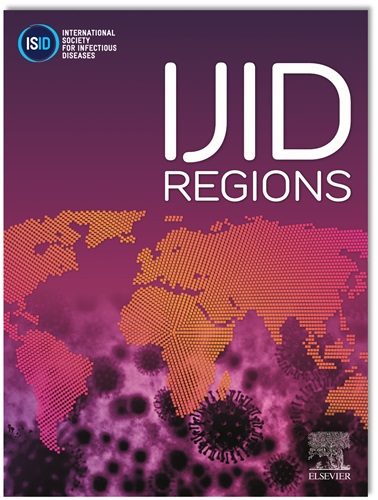刚果民主共和国、加纳和塞内加尔登革热血清流行率:SERODEN研究结果
IF 4.8
2区 医学
Q1 INFECTIOUS DISEASES
引用次数: 0
摘要
大多数非洲国家,包括塞内加尔、加纳和刚果民主共和国,关于登革热传播的数据有限。我们的目的是评估这些国家按年龄分层的登革热血清患病率,并估计感染的力量(FOI,易感受试者的人均登革热感染风险)。方法我们调查了塞内加尔的14个地区、加纳的3个城市和刚果民主共和国的2个城市,利用以前收集的0至94岁个体的SARS-CoV-2血清样本。采用酶联免疫吸附试验(ELISA)检测纯化登革热颗粒(ELISA-1)的IgG抗体水平。部分样本采用ELISA检测登革热重组非结构蛋白(NS1) IgG (ELISA-2),并采用斑块减少中和试验(PRNT)检测所有四种登革热血清型。我们使用贝叶斯方法重建研究中获得的结果,并估计登革热感染的力量,假设时间恒定传播。结果共检测IgG -1抗体8203份,其中加纳1486份,塞内加尔3137份,刚果民主共和国3580份。根据IgG ELISA结果,塞内加尔各地区登革热感染的年人均风险存在显著异质性,从达喀尔的0.2% (95% CrI: 0.1-0.3%)到法蒂克的2.6% (95% CrI: 1.9 -3.6%)不等,对应于总体血清阳性率估计分别为5% (95% CrI: 3-8%)和39% (95% CrI: 32-47%)。在刚果民主共和国,IgG ELISA-1结果获得的年平均FOI在金沙萨为2.9% (95% CrI: 2.2-3.9%),在马塔迪为1.4% (95% CrI: 0.9-2.0%),总体人群血清阳性率在金沙萨为41% (95% CrI: 34-48%),在马塔迪为23% (95% CrI: 17 - 32%)。加纳各地登革热传播强度存在很大的异质性,塔马莱的年平均传播指数为7.1% (95% CrI 5.6-9.6%),而阿克拉为2.6% (95% CrI 2.1-3.3%),库马西为0.5% (95% CrI 0.1-0.8%)。根据这些结果,我们估计分别有43%、11%和70%的阿克拉、库马西和塔马莱人群暴露于登革热病毒。值得注意的是,我们发现IgG ELISA-2和PRNT测试的整合产生了与IgG ELISA-1测试在不同地点获得的一致的估计。这项三国血清流行率研究提供了证据,表明登革热在加纳、刚果民主共和国和塞内加尔以不同水平传播,并突出了人口免疫和跨地区传播的巨大异质性。需要在这些国家和整个非洲加强登革热监测,以监测传播并应对未来的疫情。本文章由计算机程序翻译,如有差异,请以英文原文为准。
Seroprevalence of dengue in the Democratic Republic of Congo, Ghana and Senegal: results of the SERODEN study
Introduction
There are limited data on dengue transmission across most of African countries, including Senegal, Ghana, and the Democratic Republic of the Congo (DRC). We aimed to assess the age-stratified dengue seroprevalence and estimate the force of infection (FOI, per-capita risk of dengue infection for a susceptible subject) in these countries.
Methods
We surveyed 14 regions in Senegal, 3 cities in Ghana, and 2 cities in DRC, leveraging blood samples collected from previous SARS-CoV-2 serosurveys of individuals aged 0 to 94 years. An Enzyme-Linked Immunosorbent Assay (ELISA) was used to measure IgG antibody levels against purified dengue particles (ELISA-1). A subset of samples was tested by ELISA for IgG against the recombinant nonstructural protein (NS1) of dengue (ELISA-2) and using a Plaque Reduction Neutralization Test (PRNT) for all four dengue serotypes.
We used a Bayesian approach to reconstruct results obtained in the study and estimated the force of infection of dengue assuming a time-constant transmission.
Results
In total, 8203 samples were tested by IgG ELISA-1: 1486 in Ghana, 3137 in Senegal and 3580 in DRC. Based on the IgG ELISA results, there was significant heterogeneity in the annual per capita risk of dengue infection across regions of Senegal, ranging from 0.2% (95% CrI: 0.1-0.3%) in Dakar to 2.6% (95% CrI: 1.9 -3.6%) in Fatick, corresponding to overall seroprevalence estimates of 5% (95% CrI: 3-8%) and 39% (95% CrI: 32-47%), respectively. In DRC, the average yearly FOI obtained from the IgG ELISA-1 results was 2.9% (95% CrI: 2.2-3.9%) in Kinshasa and 1.4% (95% CrI: 0.9-2.0%) in Matadi, with an overall population seroprevalence of 41% (95% CrI: 34-48%) in Kinshasa and 23% (95% CrI: 17, 32%) in Matadi. There were large heterogeneities in dengue transmission intensity across locations in Ghana, with a higher average yearly FOI in Tamale at 7.1% (95% CrI 5.6-9.6%)] compared to Accra at 2.6% (95% CrI 2.1-3.3%) and Kumasi at 0.5% (95% CrI 0.1-0.8%). Based on these results, we estimated that 43%, 11%, and 70% of the Accra, Kumasi, and Tamale populations, respectively, had been exposed to dengue virus. Notably, we found that the integration of the IgG ELISA-2 and PRNT test generated consistent estimates to those obtained with the IgG ELISA-1 test across locations.
Conclusion
This three-country seroprevalence study provides evidence that dengue has been circulating at different levels across Ghana, DRC, and Senegal and highlights the large heterogeneity in population immunity and transmission across regions. Dengue surveillance needs to be strengthened in these countries and across Africa to monitor transmission and respond to future outbreaks.
求助全文
通过发布文献求助,成功后即可免费获取论文全文。
去求助
来源期刊
CiteScore
18.90
自引率
2.40%
发文量
1020
审稿时长
30 days
期刊介绍:
International Journal of Infectious Diseases (IJID)
Publisher: International Society for Infectious Diseases
Publication Frequency: Monthly
Type: Peer-reviewed, Open Access
Scope:
Publishes original clinical and laboratory-based research.
Reports clinical trials, reviews, and some case reports.
Focuses on epidemiology, clinical diagnosis, treatment, and control of infectious diseases.
Emphasizes diseases common in under-resourced countries.

 求助内容:
求助内容: 应助结果提醒方式:
应助结果提醒方式:


